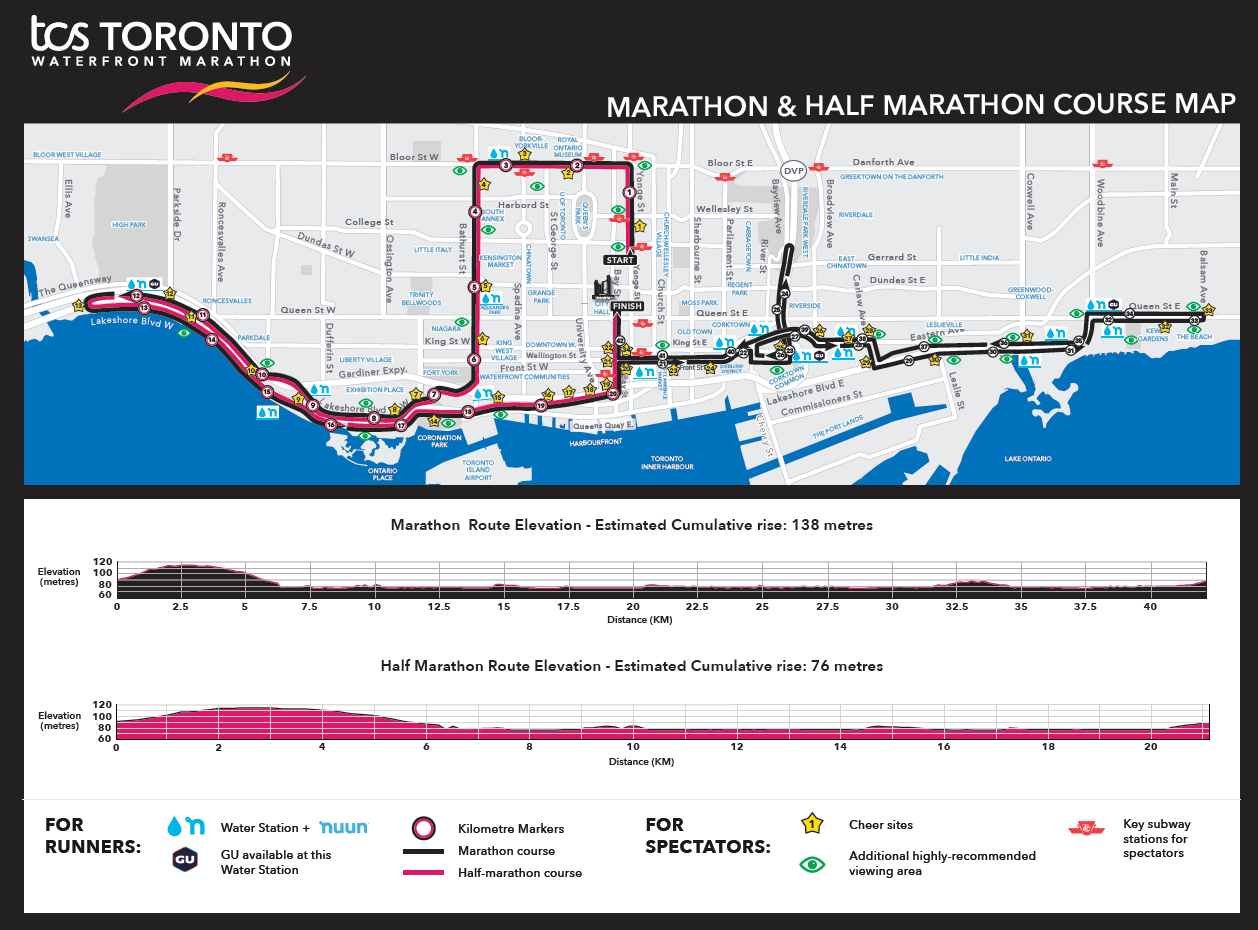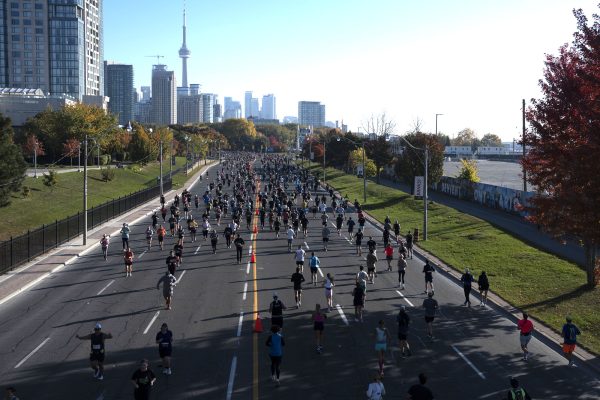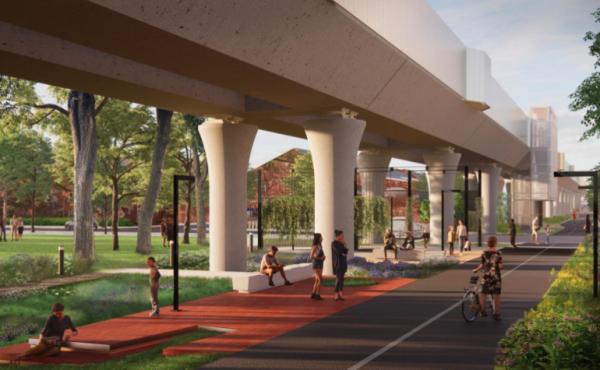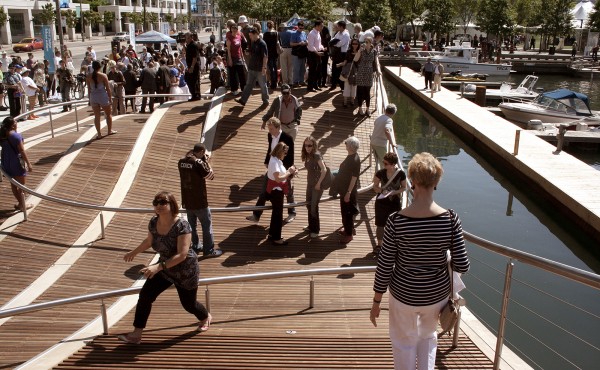Dawn doesn’t so much break over Toronto on marathon morning as creep in behind the sound of trucks, radios, and zip-ties. Streets that usually hum with commuters now sit in temporary silence, lined with orange pylons and metal fencing. City crews move quickly, transforming intersections into start corrals and traffic lights into timing markers. At Union Station, clusters of runners spill from the trains into the pale morning, adjusting armbands and watches as they make their way toward the start line. Along the waterfront, families line the barriers, balancing coffee cups and cameras, and for a moment the city seems to hold its breath.
This transformation is what makes the Toronto Waterfront Marathon more than a race. On an October Sunday each year, the marathon becomes a live experiment in how Toronto negotiates its public sphere – balancing logistics, safety, and movement all while giving runners and spectators a new way to experience the city.
Chris Fagel is President/CFO of Canada Running Series, which organizes the marathon, and the longtime course director. He describes the challenge of designing all at once for a full marathon, a half-marathon, and a 5k run: “How do you have a route that’s 42 kilometres, a route that’s 21 kilometres, another route that’s 5 kilometres, that start and finish in the same place?” The technical puzzle is constant. Add to that the geographical constraints: “Toronto has some unique challenges … we’re surrounded by water on the south and hills to north and runners don’t like either of those things.”
Behind the scenes, the event relies on a web of cooperation between city departments, including planning, transit, emergency services, and traffic management. “The city is always in flux, it’s always moving, it’s never static,” Fagel says, explaining that what works one year might not work the next, so the route must be constantly adapted.
When asked whether the route design considers what spectators see, Fagel is unequivocal: “Absolutely.” The course, then, is a narrative as much as a path: a way to show Toronto to itself, and to the runners who pass through it.
A glance at the course map for this year’s marathon reveals this ambition, with the route weaving through some of Toronto’s most recognizable areas, including Liberty Village, Roncesvalles, Bloor-Yorkville, Harbourfront, and Corktown, capturing a wide range of the city’s urban landscape.

The view from the runners’ perspective helps put that design into sharper focus.
Andreas Weichert has seen more of the world at a running pace than most people do from airplane windows. An ex-Canadian diplomat and dedicated marathoner, he has logged 27 races across continents, including one in Antarctica. Each city, he says, tells its story differently through the route it chooses.
“In Tokyo they make a real effort to bring you past the key sights,” he says. “New York makes sure you see all five boroughs.” Even in cities known for spectacle, though, the rhythm of the race changes. “Both Tokyo and Chicago have this long stretch where there’s nobody watching,” he adds. “Those are the hardest parts of the run.”
His observations highlight what Toronto’s marathon attempts each year: a course that connects its most visible places with quieter ones, threading together waterfront views, dense downtown blocks, and residential streets. “You run past something and think, I should bring my family back here later,” he says. The route, like the city itself, invites a closer look.
From his perspective, marathons offer a rare intimacy with place, letting runners feel a city’s character through its streets and the people who line them.
On marathon day, Toronto’s streets take on a new rhythm. Roads that normally divide cars, buses, and cyclists are given over to people on foot. The familiar elements of daily life such as curbs, sidewalks, and intersections become part of a different kind of city: sidewalks turn into cheer zones, intersections into vantage points, and the asphalt itself into a temporary running track alive with motion.
When the marathon unfolds, it isn’t just the thousands of runners who move differently, it’s the city itself. Traffic lights flash for no one, delivery trucks idle on side streets, and the everyday choreography of the city gives way to a new tempo. Office towers, parks, and storefronts become backdrops to a single, uninterrupted line of motion. What’s usually a network built for efficiency becomes, briefly, a network built for presence.
For the city, the race is as much a logistical achievement as an act of imagination. Each intersection and stretch of pavement must work differently for a few hours, coordinated through hundreds of people who close, monitor, and reopen the same spaces in precise sequence. It’s a kind of urban rehearsal, showing how quickly Toronto can reorganize itself when streets are treated as shared ground rather than fixed infrastructure.
The race’s energy does not come only from the runners. It builds outward through the people who line the route and the neighbourhoods that host them. Along Queen’s Quay, Coronation Park, and across the downtown core, spectators cluster in pockets of sound as cowbells, cheers, and music ripple through the open streets. In some places the crowds are thick, in others a single line of supporters breaks the quiet.
Local runner Chris DeKoning describes what that atmosphere feels like from within the pack. A familiar voice in Toronto’s running community and an on-air personality with Canada Running Series, he’s attuned to how the crowd transforms the final stretch of the race. “There’s a TV broadcasting you as you come around the corner,” he says. “You kind of feel like you’re in the Olympics.” That moment, when the cheers grow louder and the crowd closes in around the finish, captures the collective spirit that defines race day. Every shout from the curb, every burst of music from the sidelines, folds into a shared sense of participation that reaches far beyond the finish line.
That feeling spreads through the city as the day unfolds. Cafés fill earlier than usual, curbs become front rows, and neighbours gather on balconies or sidewalks to watch. Volunteer crews hand out water, musicians play along the course, and small businesses bring in new faces from across the city. The marathon becomes a civic gathering that links people who might otherwise never meet, uniting them in the simple act of cheering for others.
When the last runners cross the finish line and the barricades begin to lift, what lingers is the sense of what those streets made possible. For a few hours, the marathon turns ordinary corridors of traffic into places of connection. It shows how easily Toronto’s infrastructure can host community when people, rather than vehicles, take centre stage. The challenge is to hold onto that spirit—to see the race not as a one-day event, but as proof of how the city can come together when its streets are shared.
This year’s marathon on Sunday October 19 will leave behind more than empty coffee cups and folded barricades. It will remind us what Toronto can become when its streets are used for connection instead of congestion. For a few hours, roads meant for traffic will turn into spaces for gathering, cheering, and collective movement.
The transformation is fleeting, but it proves what is possible. If one morning can draw thousands into the streets to share in a single event, then those same spaces can host other moments of civic life. Open streets, cultural routes, and neighbourhood gatherings all build on the same idea—that the city is most alive when its streets serve connection, not the constant chase for movement.
The race may end before 2 pm, but it will linger as a quiet reminder that community does not disrupt the city’s flow; it defines it.
Images courtesy of Toronto Waterfront Marathon



